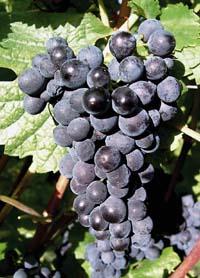Turn to grapes came
2007/10/07 Galarraga Aiestaran, Ana - Elhuyar Zientzia

A group of geneticists led by French decode the genome of the vine. Specifically, the DNA of the Pinot Noir strain has been sequenced, with a total of more than 30,000 genes. It should be noted that the vine is the first sequenced fruit plant and the fourth of all flowering plants. Therefore, for Mahatsa it is an honor to have been chosen to decode, and for the French it is also an honor to have led the work, although Italian researchers have also participated in the group.
Wine flavor genes
The vine (Vitis vinifera) has many genetic variants. The researchers chose a variety that gives flavor to the wines Pinot Noir, Borgoina and Champagne, and that was crossed for several generations so that the genome of the grapes studied had the least possible genetic variety. Subsequently, the DNA of this pure variety was divided into millions of parts, sequenced each of them and, through a computer program, ordered and joined all sequences to form the genome.

As expected, many genes associated with compounds that flavor wine have been identified. For example, 70-80 genes control terpene production. Precisely, terpenes have a great influence on the taste of wine, and the vine has many more genes related to these compounds than other plants with sequenced genome, three times more genes than the Arabidopsis plant used in research.
According to researchers, the identification of these genes can be very useful for winemakers, as they can try new gene combinations to create different flavors. However, other researchers are not of the same opinion, they believe that changing genes if necessary is not the best way to improve the taste of wine, since many other variables influence the production of compounds that flavor wine, such as the time or conditions in which the grape grows.
But surely knowing the sequence will be useful to combat pests. Many grape varieties have been lost due to mold, so it would be good to know which genes protect from mold. Crossing the varieties that contain these genes with other varieties, new mold resistant varieties could be obtained.
Solving evolution

It is also interesting for scientists who study the evolution of plants to know the sequence of the vine. In fact, its genome bears witness to an important fact that occurred 250 million years ago: the flowering plants were divided into two groups, the dicotyledons (trees, fruit plants and baracias) and the monocotyledons (herbaceous plants like wheat and rice, and flowers like orchids).
Comparing the sequence of the vine with that of other plants that have decoded, they have seen that it is closer to the chopal or Arabidopsis than to the rice. They have also known when he separated from them.
However, although geneticists have published many secrets of the vine, they have recognized that their work is nothing more than a step in the knowledge of the grape, and that you can not do without the knowledge acquired through experimentation for thousands of years.
Published in 7K.

Gai honi buruzko eduki gehiago
Elhuyarrek garatutako teknologia





